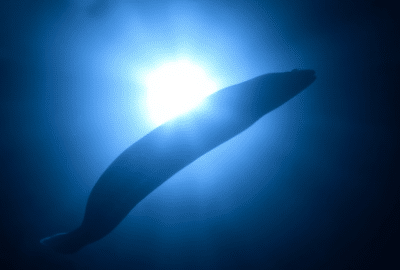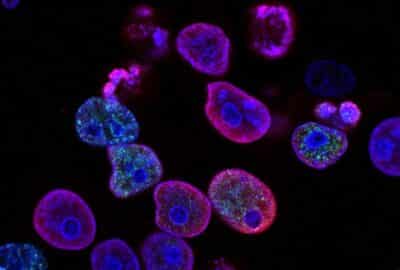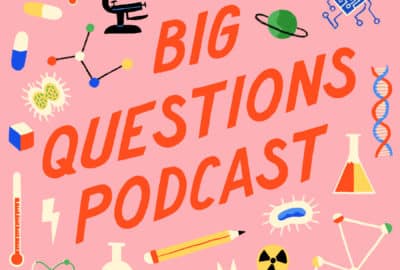Why is Rudolph’s nose red?
Wednesday 22nd Dec 2021, 12.30pm
“Rudolph the red-nosed reindeer, had a very shiny nose…” Many of us will be very familiar with Santa’s famous antlered friend. But did you know that many reindeer actually do have red noses? But why? In this festive episode of the Big Questions Podcast, we ask Oxford polar biologist Ignacio (Nacho) Juarez Martínez to share some of the reasons we find red pigments in animals, and to explain why he thinks Rudolph’s nose is so red!
Emily Elias: Rudolph the Red-Nosed Reindeer had a very shiny nose. In fact, a lot of reindeer have red noses. Seriously. That part of the song is accurate but why is that that? On this festive episode of the Oxford Sparks Big Questions podcast, we’re asking, why is Rudolph’s nose red?
Hello. I’m Emily Elias and this is the show where we seek out the brightest minds at the University of Oxford and we ask them the big questions. For this one, we’ve found a researcher who’s willing to step outside his normal scientific comfort zone for this very special Christmas Episode.
Ignacio (Nacho) Juarez Martínez: Hello. My name is Ignacio Juarez but please call me Nacho, everybody calls me Nacho. I am a PhD student at Penguin Watch, a research group based at the zoology department at the University of Oxford and I study penguins and penguin ecology and how climate change affects them.
Emily: We’ve come to you for not quite a penguin story. We’re actually looking for this big answer this holiday season of why is Rudolph’s nose red? I mean, Nacho, what is going on with reindeers’ noses?
Nacho: That is a fantastic biological question, actually, because vertebrates in general, and Rudolph is a mammal and, therefore is a vertebrate, cannot produce red pigments so how could Rudolph have an actual red nose, like, bright red? There are actually two ways in which Rudolph could have a red nose.
The first one is the same way that, for example, flamingos get their red colour or king and emperor penguins get their orange patches or, I don’t know, if you’re thinking of North America, cardinals, they’re all completely red and they’re also vertebrates. How do these animals get that red colour?
All of them get their colour from eating, for example, flamingo, they eat little crustaceans and if you think crustaceans are prawns, so orange, so by eating orange. The cardinals and the birds, they get them by eating red berries. They incorporate these little colours into their feathers or their hair or whatever their pigments are and that constitutes what in biology we call honest signalling.
Honest signalling is a way of an individual to tell their partner or their possible partners, “Hey, look how well fed I am, look how well I eat my veggies, look how well I get all of the food for myself and if I am so good at getting food for myself, I will surely be a great partner to bring back food to the nest or to the den or the burrow or wherever.” So, one of the options would be that Rudolph actually has his red nose from eating a lot of veggies.
Emily: That’s one possible reason that Rudolph is the healthiest reindeer out there but there’s another reason you said. What could that be?
Nacho: The other reason is that, if you think about it, vertebrates, we can produce one red pigment and it’s the one that’s in our blood and that’s haemoglobin. The other possible reason is that, actually, the reason why Rudolph nose is red is because it’s full of blood but, actually, that doesn’t make a lot of sense to have a bright red nose full of blood in such a cold environment, especially going at the incredible speeds that Rudolph goes.
So, how could this be? The answer could actually be, I’m sorry to bring this back to my field, penguins and other animals adapted to living in cold conditions. This is the same answer for how do penguins’ feet not get cold and their flippers and their noses when they’re breathing in and out frigid air?
The answer is the wonderful network or rete mirabilis as it was called in Latin when this was discovered almost 2,000 years ago. What happens with this awesome network is an awesome network of capillaries, of blood vessels, going in and out and, in the case of Rudolph, in and out of their nose to give this bright colour.
The way this awesome network works is by putting capillaries, blood vessels, very close to each other. The blood vessels that are coming out with warm blood, they need to be cooled down before they reach the outside to not lose the temperature and the cold blood through the inbound vessels needs to get warmed up before bringing in that cold to the body of the reindeer because that could cause hypothermia.
What the rete mirabilis does, what the awesome network does, is that it puts the cold and the warm vessels together, very fine vessels, very close together so the warm blood gets cooled down before going out and the cold blood gets warmed up before going in.
Emily: Can you explain to me in a visual way?
Nacho: More visually, this would be something like, imagine that you are coming out of the metro station or out of the tube station and you see you have the escalators going up and the escalators going down. You wouldn’t want the people going out to get cold so one thing that could happen is that the people coming in from the cold and going into the tube, they don’t need their coats anymore, they could hand over their coats and their jackets to the people that are going outside.
For that to happen, for that to protect the people going outside with the coats and be able to reuse the coats, let’s think that it’s all collaborative. This is all within one organism. To be able to hand over the coats within the escalators, the escalators need to be very close to each other and this is like many escalators going out intertwined with many escalators going in and that is what this awesome network is.
Emily: This awesome network or wonderful network, I guess the names are interchangeable, we have this in penguins and we apparently have this in reindeer’s noses possibly explaining why Rudolph’s nose is red. Do any other animals do this?
Nacho: Yes. This is very common and this is something that has evolved separately in many species that have had their ranges expanded into colder territories. This is something that we see, for example, in the noses of the polar bears to be able to breathe out colder air rather than breathing out their temperature away.
This is something we find in sharks, in gills of many fish that live in cold temperatures. This is something that we find all throughout the animal kingdom in many, many, many animals whose species distribution has ventured into the polar regions.
Emily: As humans, we don’t have it because, if I was to stand on a block of ice like a penguin does, my imagination is that I would just get hypothermia.
Nacho: I think you would get hypothermia pretty quickly. I think in under 20 minutes you would be needing a very big warm soup.
Emily: Rudolph the Red-Nosed Reindeer, the song that goes along with the history or, I guess, the folklore of Rudolph, that also has some truth in science?
Nacho: Yes. In the song you hear how the other reindeer used to call him names just because of being different but, actually, it is that difference, it is that bright red light that saves the day and that saves Santa flying through the skies and guiding him.
He’s the one that saves the day and ends up being praised and that has a big, big correlation with biology and evolution. Biology, in general, has created a diversity of organisms to make sure that each species has all of the possible solutions that they could need to move on to the next generation.
If I wanted to make this point, especially with kids, there are so many of them that are being called names for being different and I think, just from the point of view of biology, if you’re ever called names for being different, don’t worry, that means you have capabilities that no one else has, that means that you’re literally extraordinary and your capabilities will help you save the day someday.
Emily: Nacho, can I ask you something a little bit off topic? Could a polar bear open a bottle of cola?
Nacho: That is actually a great question because the thing is that polar bears are part of the plantigrade family and plantigrade literally in Latin means they walk by resting their weight on the palm of their hands. What this evolutionary has meant for them is that all of their fingers are pointing forward so none of their fingers is, what in biology what we call, apposable.
That means that with your thumb, you can touch the tip of your other four fingers. Polar bears cannot do that and, hence, they can’t really grab anything and, because they can’t really grab anything, they can’t really grab a cola so polar bears do not get cola for Christmas.
Emily: I guess they can’t also share them with penguins?
Nacho: Yes. Definitely one of the things that they can never is to share their cola with a penguin, not only because they cannot grab it but because polar bears live in the Arctic, which literally means bear, and penguins live in the Antarctic, which literally means opposite to where bears live.
Emily: This podcast was brought to you by Oxford Sparks from the University of Oxford with music by John Lyons. A very special thanks to Nacho Juarez. Spread some festive cheer, why not, rate and review us on whatever podcast app that you use. That would be a great gift for us or go find us on the internet and tell us what you like, what you don’t like and if you’ve got a big question. We’re all ears. We are @oxfordsparks or go to our website, oxfordsparks.ox.ac.uk. I’m Emily Elias. Bye for now.
Transcribed by UK Transcription.





